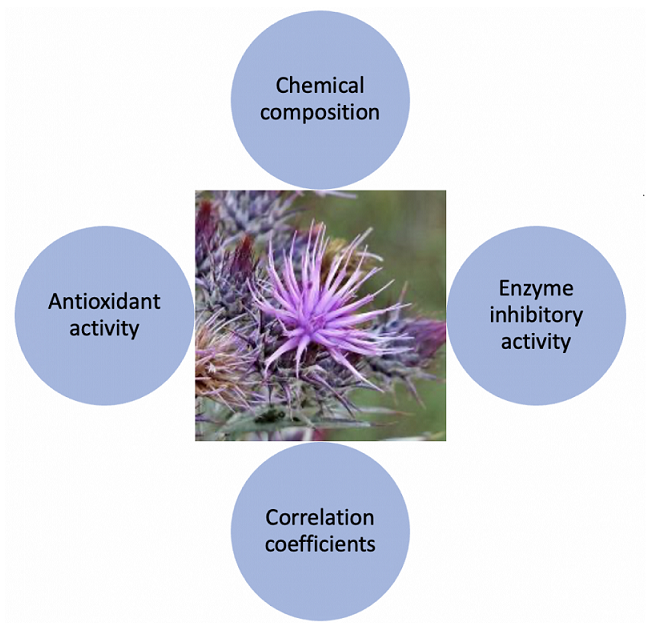JOURNAL 2116
Records of Natural Products
Year: 2022 Issue: 2 March-April
p.172 - 181
Viewed 2596 times.
GRAPHICAL ABSTRACT

ABSTRACT
Plants are rich sources of biologically and/or pharmacologically active phytochemicals. This study aimed to determine the chemical composition, antioxidant, tyrosinase, anti-cholinesterase, and anti-diabetic activities of ethyl acetate (EtOAc), methanol (MeOH), and water extracts obtained from the aerial parts of Onopordum caricum (Hub.-Mor.), which is an endemic plant species to Turkish flora. As a result of spectrophotometric analysis, the MeOH extract was the richest in total phenolics and flavonoids (46.26 mg GAEs/g and 20.97 mg QEs/g, respectively). In quantitative chromatographic analysis, the MeOH extracts contained considerable amounts of chlorogenic acid, eriodictyol, luteolin 7-O-glucoside, vanillic acid, syringic acid, 4-hydroxybenzoic acid, and pinoresinol. Except for the ferrous ion chelating activity assay, MeOH extract showed higher activity than others in all test systems. The activity data exhibited by the MeOH extract in phosphomolybdenum, DPPH and ABTS radical scavenging, CUPRAC, and FRAP tests were 1.46, 1.10, 1.30, 0.87, and 0.76 mg/mL, respectively. The EtOAc extract showed higher activity in all enzyme inhibition assays. The AChE, BChE, α-amylase, α-glucosidase and tyrosinase inhibitory activities of this extract were 0.95, 1.20, 2.37, 1.18 and 1.77 mg/mL, respectively. There was a very high correlation between the extracts' total phenolic and flavonoid contents and their antioxidant activities (phosphomolybdenum, radical scavenging, and reducing power). Since the antioxidant and enzyme inhibitory activity data presented in the current study were found to be higher than the activities of some other Onopordum species in the literature, it was concluded that the plant species in question could be used in the treatment of Alzheimer's, diabetes, hyperpigmentation, and disorders occurred as a result of oxidative stress pressure.
KEYWORDS- Onopordum caricum
- antioxidant activity
- chemical composition
- enzyme inhibitory activity